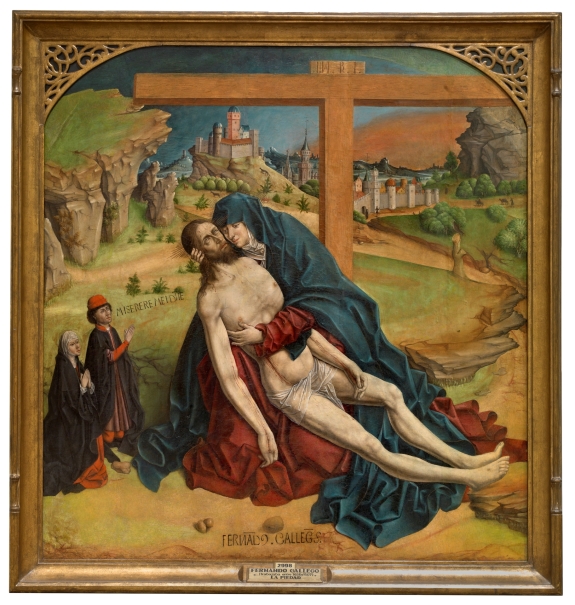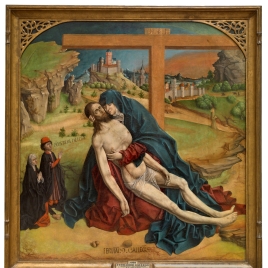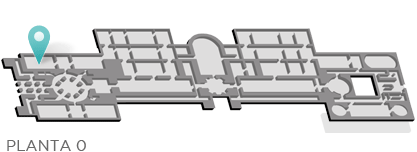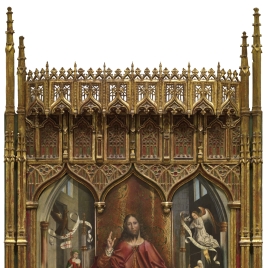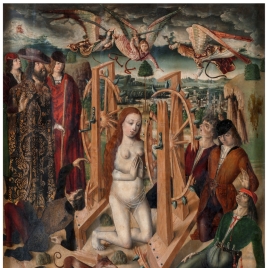Pietà
1465 - 1470. Mixed method on pine panel.Room 051A
By all indications, this panel at the Museo del Prado with the signature FERNA[N]DO GALLEG[U]S is the earliest surviving work by that painter from Salamanca. While some scholars think he must have made it around 1480, the donor’s fashionable clothing, short hair and high cap suggest that the artist must not have painted this panel any later than 1470, and it very likely dates from a few years earlier. Sadly, the donors’ identities are unknown, as is the work’s intended destination. Its characteristics and dimensions indicated that it was commissioned as an independent work and was thus probably made for a funeral monument. This is suggested not only by the subject but also by the upper edge, whose low arch-like curve was very fashionable at that time, although it differs from the funerary images made for the cloister at Salamanca Cathedral. Depicted on a smaller scale, the donors intone the Miserere mei Domine (Lord have mercy on me) that begins Psalm 50, thus seeking Christ’s forgiveness in order to merit the fruits of Redemption. On this panel, Fernando Gallego represents the Pietà or fifth Anguish, whose origin is not in the Gospels. Instead, it arose in Germany in the 14th century as a means of showing the Virgin’s anguish at the foot of the cross as she received her Son’s lifeless body. Its iconography is derived from the Virgin as Our Lady of Humility, sitting on the ground with her Son on her knees, but replacing his image with that of Christ as he appeared after the Crucifixion. The addition of this motive -the Virgin embracing Christ at the foot of the cross- to the iconography of piety reflects the Italian trecento’s influence on the Northern world towards the end of the 14th century. Like many other painters of his time, Fernando Gallego drew Rogier Van de Weyden in making this panel, as the latter left a strong mark on this and other subjects. Here, Mary wears a tunic whose red color alludes to Christ’s Passion, and blue robes that also cover her hair. She sits at the foot of the cross, which is not centered in the composition, but instead shifted to the right. Her lightly sketched figure forms a pyramid with her tunic and robes, occupying much of the available space in the foreground. The almost total absence of gold except for the lines that form Christ’s halo, and the power and intensity of the red and blue that make up the Virgin’s clothing and contrast with the pallid flesh of her lifeless Son, were intended to have a great impact on the faithful. Moreover, the breadth of her clothing, presented with multiple deep folds, adds a disturbing and disquieting element to the interior of the compositional pyramid. With white eyes, a lifeless facial expression and the marks of the passion on his body, covered exclusively with a transparent loincloth, Christ lays diagonally in his Mother’s knees. And rather than resting his feet on the ground, Fernando Gallego rests them on a stone that he places in the foreground for that purpose, revealing his originality and decorative taste. To his added credit, he recreates Rogier Van der Weyden’s model in Christ’s distorted legs, as is his custom, which also brings a degree of instability and movement to the interior of the pyramid established by the Virgin’s body. Fernando Gallego dispenses with Christ’s wounds and blood, which are usually included in depictions of the Pietà, concentrating the scene’s dramatic strength in the Virgin’s intense embrace of her Son. Mary leans over her Son and kisses him, strongly embracing him with her arms and holding him by the head and waist. Thus, she clearly conveys her enormous grief and anguish in her drawn, teary face. This presentation differs from Rogier Van der Weyden’s works in its depiction of the Virgin’s embrace -both in how she holds her Son’s head and, most of all, in how she wraps her left arm around his waist. In this version by Gallego, Mary’s hand covers the wound on Christ’s side and the latter’s left arm runs along his body, even though the end of his arm and hand rest on his leg. His right arm also runs along his body, although it is somewhat separated, and his hand rests on Mary’s red tunic. Thus, Fernando Gallego manages to reduce their rigidity, adding greater rhythm, just as he did with Christ’s legs. To emphasize Mary’s solitude at the foot of the cross, he represents her without any of the elements that Weyden included in some of his versions, placing her, instead, in a stylized landscape on a plane that is sharply inclined at the base, with an animated background and a walled city that presents Jerusalem as if it were a medieval city, with a few tiny figures. The only thing Gallego places in the immediate foreground is his signature, which appears in Roman characters, separated from the holy figures by a stone, in much the same manner as the two doors (Text drawn from Silva P.: Fernando Gallego, 2004, pp. 130-135).


